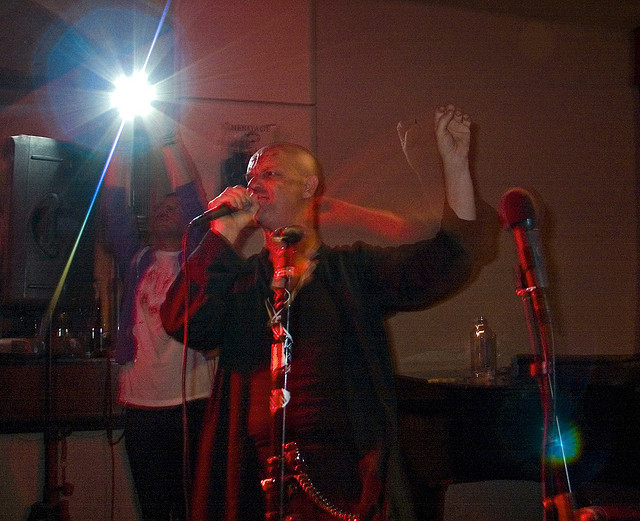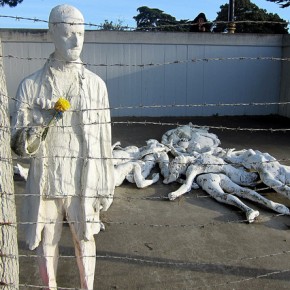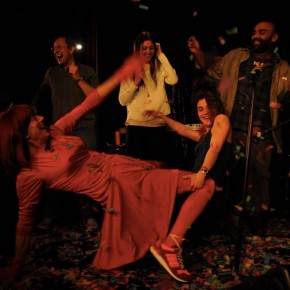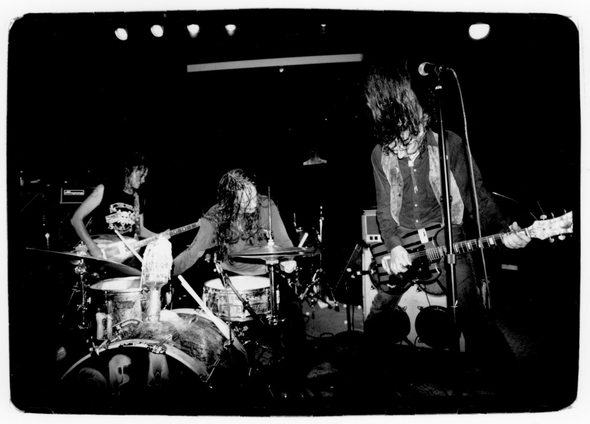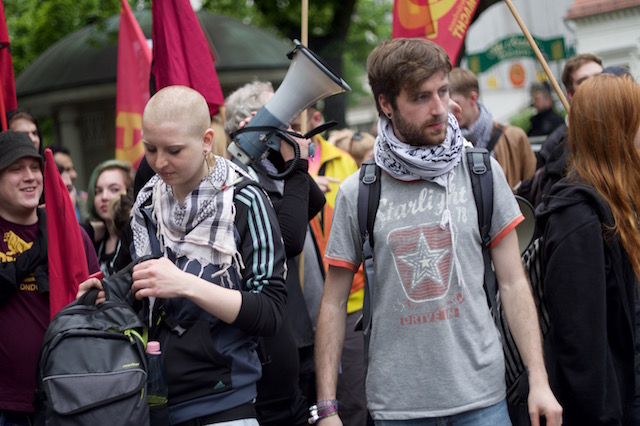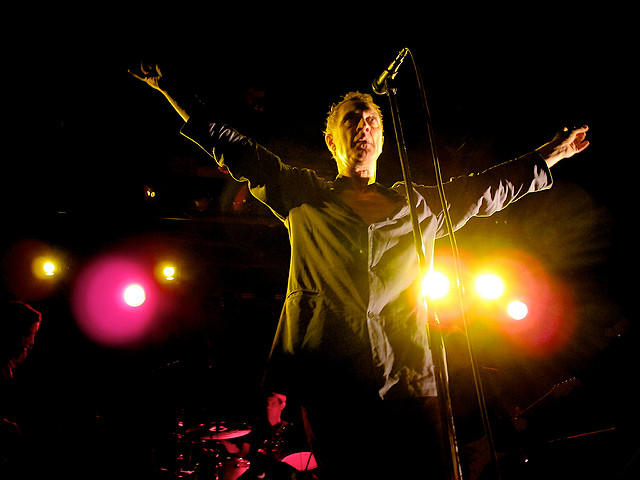I first started listening to punk and hardcore in 1988—not that music’s best period. Many of the great early bands, including the Dead Kennedys, Black Flag, and Crass, had broken up a couple years before, and it seemed that the genre might be at its social and aesthetic end. The politics were fading while metalcore and straightedge hardcore bands were in ascendance.
The Exploited’s ubiquitous skull-and-mohawk symbol represented how formulaic those repping the older punk sound had become, while venerable labels like SST were busy making fake jazz records. The 1990s DIY/anarcho/feminist scene around Bikini Kill, Fugazi, and Citizen Fish was yet to bloom.
Many of the old classic records had gone out of print and were yet to be reissued, and Youtube was still a concept in a William Gibson novel. And since grunge’s “alternative” revolution had not yet arrived, changing the major labels’ policy against signing underground rock bands, a thousand people might attend an underground DIY show—where 50 skinheads would stand in the middle of the pit and intimidate the other 950 concert-goers.
In this context we huddled around suburban living rooms and watched the one copy of Decline of Western Civilization that our local Hollywood Video had mistakenly stocked. The Los Angeles scene had spun out bands like Germs, X, Fear, the Circle Jerks, and Black Flag. This was one of the origins of the Loud Fast Rules approach, but you could tell there was something else going on: the Bags, X, and Catholic Discipline were starting from somewhere completely different than Youth of Today and Biohazard.
I mail-ordered the few books about the early days of punk that I could find, including Peter Belsito and Bob Davis’s Hardcore California: A History of Punk and New Wave, an account of LA and San Francisco punk from 1977 to 1983. Reading it, I was fascinated and saddened to find out the story of the early LA scene, which has always stuck with me as a kind of punk rock morality tale.
It was immediately clear was how different it was from what I was around. The scene seemed wildly more mixed in terms of race, gender, and sexuality. The music could be very far out: performance art, synthesizers, and gender-bending performance mixed with Marxist politics, American roots and traditional Mexican music, and elements from formal art and theater. In fact, only a few of the 1970s bands actually presaged the later hardcore direction that defined the 1980s.
In the hardcore scene I was first exposed to, being openly gay would not have been physically safe at most shows. But in We Got the Neutron Bomb: The Untold Story of L.A. Punk, Brendan Mullen, founder of the Masque club (the center of the early Hollywood scene), described “the mostly closeted but considerably large don’t-ask-don’t-tell homo constituency within the old Hollywood/Masque scene” as being “30–35 percent gay, maybe even more.” There are differing accounts of how closeted people were, but crews of skinheads looking to attack queer kids didn’t seem to roam the shows at the Masque.
One of the more fascinating, and only openly queer, bands from this era was Nervous Gender. San Francisco’s Subterranean Records (Flipper, Pop-O-Pies) had remained active into the 1990s, so I mail-ordered the band’s sole album, based on the strength of two sentences in Hardcore California (which included the curio that lesbian folksinger Phranc had been an original member). Music From Hell was a bizarre, outlandish, sexually transgressive, and completely wonderful blast of synthpunk. While I had heard post-punk and early new wave, this all-synthesizer band played aggressive, raw music: the synths did not you wash over you like waves or wail like dark warnings from the underpass; they clubbed you on top on the skull, punk rock style. Nervous Gender somehow simultaneously either intersected or presaged punk, post-punk, gothic, industrial, and No Wave. It was a perfect antidote to the macho and strictly formulaic hardcore scene I had first experienced. And it was gone.
The sad story about the early LA/Hollywood scene is how it ended. I loved (and still do) early area punk bands like Black Flag, the Circle Jerks, and Social Distortion. As Hardcore California showed, and numerous accounts testify, punk spread from the close-knit, queer, arty Hollywood scene around the Masque to the suburban LA hardcore scene, where a violent, macho, standardized approach took its place. Decline of Western Civilization documents the moment of this transition, with half the bands from the downtown past, and the other half the suburban future.
Recently, and to my pleasant surprise, the Internet told me that Nervous Gender had not just reformed (in fact, they had still been together when I first heard them, only breaking up in 1992,) but that they were playing a free show in Brooklyn. This allowed me to cajole an interview, where they humored my peppering them with questions about the early LA scene—although I don’t think they expected my more political queries. (Spending excessive time in Left-wing and ANTIFA circles has no doubt desensitized me to the fact that everyone does not obsessively analyze every cultural work in terms of race, gender, sexual orientation, and proximity to the nearest fascist performer.)
Tammy Fraser (a friend and later manager of Nervous Gender, before becoming the keyboardist of the reformed band,) said that Decline of Western Civilization felt like a “betrayal” to some of the older Hollywood punks, who had helped out director Penelope Spheeris—only for her to place the emphasis on the newer hardcore bands, while playing up the violent elements in the scene. After the change, Fraser said, “you had to stop going to certain shows.”
Edward Stapleton, one of the original band members, told me, “People were getting their idea of what punk was from the news. So they would see ‘A Stabbing at the Starwood,’ and think ‘that’s what’s supposed to happen at shows’. The violence started to become more real.” Joe Zinnato, who joined the band in 1989, said “It’s like there was overnight punks: the day before they were football jocks, the very next day they’d be wearing chains and flannel shirts and beating on the people who had been around for years. So I stopped going to shows because I didn’t feel safe anymore. So we all kinda faded into the background.”
For me, one of the more surprising things was the band’s relation with the more reactionary elements of the punk scene. Fear—the notoriously homophobic band which drew on Nazi imagery for at least one album—had opened a show for Nervous Gender. Despite their pubic performance, Zinnato said their homophobia “was all schtick… in private life, none of them were like that.” That would have been a surprise to their fan base where I was.
Even further out was Boyd Rice, an early industrial musician who later made his way deep into organized neo-Nazi political circles. Michael Ocoha—who was a founding members of Nervous Gender with Stapelton, Phranc, and Gerardo Velazquez—did not share my concerns. Ocoha said Rice “was friendly to us and we’re a bunch of fags, and I’m Mexican, and Gerardo is Mexican… And then [Boyd Rice] goes to England and all of a sudden he’s a Nazi or something.” Stapleton added, “Yeah, so, who knows.”
It’s hard for me to watch Rice’s appearance on Tom Metzger’s neo-Nazi TV show and be nonchalant about this: there, Rice talks about how electronic and industrial music is special because it is “white music,” untarnished (as rock and roll is) by black influences, and when Metzger offers that industrial music is “a new propaganda art form for white Aryans”—that can evade the supposed Jewish control of the media—Rice replies, “Yeah, yeah, I think so.”
Perhaps it was inevitable that this sort of mixture, which undoubtedly helped make the scene so vibrant, was also slated to explode into its constituent elements. It is hard to imagine the same scene spinning out Fear and Black Flag also birthing bands as diverse as the Go-Go’s, Phranc, Johanna Went, Wall of Voodoo, Christian Death, Los Lobos, Dream Syndicate, and the Blasters. Fraser said, “all those scenes fragmented into little different scenes. There was like the real art and performance art scene, and then there was in LA that whole roots rock with the Blasters and the country kinda stuff that started, and the Paisley Underground … so everything just kinda fragmented away from being called punk.” Stapleton added, “And people who would have originally played with each other would no longer do that.”
All of this made me, like many historians often do, play What If? The early LA hardcore scene had helped set the template for the rest of hardcore in the 1980s and into the 1990s. So What If history had taken the other fork in the road, and the earlier LA Hollywood scene, instead of the later suburban Orange County scene, had set the punk template instead? What would 1980s punk have looked like then?
While there certainly were many other interesting musical movements of the 1980s that used synthesizers and were more open to diverse genders and sexualities—like New Wave, goth, darkwave, and industrial—they either didn’t have the popular appeal of punk or they lacked the biting social/political counter-cultural thrust that made it different than other movements. As much as I liked New Wave, it always seemed to rhyme with shopping malls, and not Paris ’68.
Maybe I’m mentally refighting battles that—even if they are not completely won—the tide has certainly turned in. After Bikini Kill, no one bats an eye at women on stage, and openly queer and even trans punks are common throughout the scene. Here in Brooklyn, the Latino Punk Fest is an annual event. And you can see Nervous Gender play once or twice a year if you live in California.
But, nonetheless, in my punk rock Choose Your Own Adventure book, it’s still Nervous Gender—and not Black Flag—that sets the tenor for the development of punk in the 1980s.
Photograph courtesy of Licorice Medusa. Published under a Creative Commons license.
